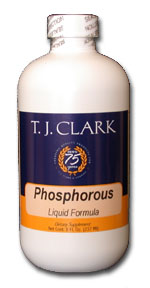| Liquid Phosphorous
 T.
J. Clark Liquid Phosphorous: T.
J. Clark Liquid Phosphorous:

Phosphorus (P) is an essential mineral that is
found in all cells within the
body. The body of the human adult contains about 400-500 g. The
greatest amount of body phosphorus can be found primarily in bone
(85%) and muscle (14%). Phosphorus is primarily found as phosphate
(PO4 2-). The major building blocks of biology are covalent molecules
comprising proteins, polysaccharides, and nucleic acids. The nucleic
acids deoxyribonucleic acid (DNA) and ribonucleic acid (RNA) are
polymers based on phosphate ester monomers. The high-energy
phosphate bond of ATP is the major energy currency of living
organisms. Cell membranes are composed largely of phospholipids. The
inorganic constituents of bone are primarily a calcium phosphate salt
called hydroxyapatite. A variety of enzymatic activities are controlled by
alternate phosphorylation and dephosphorylation of proteins. The
metabolism of all major metabolic substrates depends on the functioning
of phosphorus as a cofactor in a variety of enzymes and as the principal
reservoir for metabolic energy.
Deficiencies: Dietary phosphorus absorption is about 60-70%; any
excess absorbed is readily excreted in the urine. Since renal
conservation of phosphorus occurs quite efficiently on low phosphorus
diets, a deficiency rarely occurs in a healthy population. However,
various disease states or conditions (e.g., gastrointestinal malabsorption,
diabetes mellitus, renal tubular dysfunction, antacid abuse, and
premature birth) can be associated with low blood phosphorus levels
(i.e., hypophosphatemia) and depleted phosphorus stores.
Diet recommendations: New recommendations for dietary phosphorus
include a value, the Recommended Dietary Allowance (RDA), which an
individual should aim to meet, and a value, the Tolerable Upper Level
(UL), which should not be exceeded. Intakes between the RDA and the
UL ensure that serum phosphorus levels will be maintained in the normal
range. Values for infants are called Adequate Intake (AI) levels, and are
based on a significant portion of intake being from breast milk. It should
also be noted that there are no additional requirements for P during
pregnancy or lactation. The Recommended intake levels for P (mg per
day) are set based on life stage groups. For infants 0 to 6, and 6 to 12
months, the RDA is 100 and 275 mg, respectively. No UL has been set
for these ages as supplementation would be unlikely. For children 1 to 3
and 4 to 8 years, the RDA is 460 and 500, respectively, and the UL is
3000 mg. For youth 9 to 18 years, the RDA is 1250 mg, which
indicates the higher need for phosphorus during the adolescent growth
spurt; the UL for youth is 4000 mg. Adults 19 years and older have an
RDA of 700 mg. The UL is 4000 mg up to age 70, then declines to
3000 mg after age 70 years.
Food Sources: Phosphorus is found widely distributed in foodstuffs. In
the United States, the average daily intake is about 1600 mg for males
and 1000 mg for females. In general, food sources rich in protein (milk,
meat, eggs, legumes and grains) are also high in phosphorus. The relative
contributions of food groups to phosphorus intake are: 60% from milk,
meat, poultry, fish, and eggs; 20% from cereals and legumes; 10% from
fruits and fruit juices; 4% from alcoholic beverages; and 3% from soft
drinks and other beverages.
Toxicity: A diet containing a 2:1 dietary ratio of phosphorus to calcium
can cause low blood calcium (hypocalcemia) and secondary
hyperparathyroidism with excess bone resorption and bone loss in
animals. Human breast milk, with a lower phosphorus content than cow
milk, is considered better suited to the needs of the infant. For older
ages, typical diets in the United States frequently exceed the
recommended ratio; however, these diets are not believed to be harmful
unless calcium intake is also very low. As intake of phosphorus rises, so
does serum phosphorus. Elevated serum phosphorus levels
(hyperphosphatemia) can occur in patients with renal failure due to a
poor ability to excrete phosphorus in the urine. As indicated by UL
values, intake of phosphorus exceeding 3 to 4 grams may be harmful in
healthy individuals.
|
Supplement Facts
Serving Size: 1/2 Tablespoon (8ml)
Serving Per Container: 30 |
| |
Amount
per serving |
% USRDA |
|
Calories |
4 |
<2 |
|
Total Carbohydrate |
1 g |
<2 |
|
Total Fat |
0 g |
0 |
|
Sodium |
0 g |
0 |
|
Phosphorus |
350 mg |
50 |
|
Phytogenic Mineral Catalyst |
100 mcg |
** |
|
Calcium, Chloride, Cobalt, Chromium, Magnesium,
Boron, Manganese, Molybdenum, Selenium, Iron, Copper, Phosphorus,
Sulfur, Potassium, Iodine and Zinc |
|
* Percent Daily Values based on a 2,000 calorie
diet
** No daily value established |
|
Directions: Take 8 ml once daily with food |
|
* This statements have not been
evaluated by the Food and Drag Administration.
This products are not intended
to diagnose, treat, cure or prevent any disease. |
|
|

